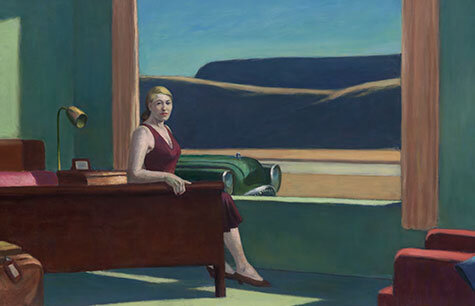
Edward Hopper and the American Hotel Opens at the VMFA October 26
by Charles McGuigan 10.2019
Above: Western Motel,1957 Edward Hopper (American, 1882–1967), oil on canvas, 36 58 x 48 58 in. Yale University Art Gallery, New Haven, Connecticut.
Edward Harper, unlike any other American artist, captured on canvas the true nature of our national psyche. That rootlessness. That constant search for sense of place. That utter and final aloneness. His backdrops are often as stark and spare as a Raymond Caver short story, and peopled with just a few characters, but, more often than not, just one.
The Virginia Museum of Fine Arts presents the premiere of Edward Hopper and the American Hotel, the first in-depth study of hospitality settings depicted in the works of one of the most celebrated American artists. The show runs from October 26, 2019 through February 23, 2020.
Edward Hopper (1882–1967) found artistic value and cultural significance in the most commonplace sites and settings. Hopper’s spare depictions of familiar public and private spaces are often understood within the contexts of isolation, loneliness, and ennui of early and mid-20th-century America.
Curated by Dr. Leo G. Mazow, the Louise B. and J. Harwood Cochrane Curator of American Art at VMFA, assisted by Dr. Sarah G. Powers, the exhibition features Hopper’s depictions of hotels, motels, tourist homes, boardinghouses, and apartment hotels. These images of hospitality settings both challenge and expand the themes of loneliness and fragmentation usually attributed to his work. They inform our understanding of a shifting American landscape and America’s fascination with the new possibilities of automobile travel and the attendant flourishing of hotels, motels, and tourist homes. Hopper was not only a frequent traveler and guest of all variety of accommodations, but worked as an illustrator for hotel trade magazines early in his career. Thus, his work offers an insider’s perspective into the hospitality services industry during a pivotal moment in its evolution. Exhibition visitors will recognize how hotels and motels—as figurative or metaphorical destinations—have fixed themselves in our experiences and permeated our collective psyche.
This exhibit presents sixty-five paintings and works on paper by Hopper, along with thirty-five works by other artists including John Singer Sargent, David Hockney, Berenice Abbott, and others who explored similar themes. The exhibition additionally features Hopper’s early commercial work from two widely read hotel trade magazines of the period: Hotel Management and Tavern Topics. Also on display are materials related to Hopper’s trips to Richmond, Virginia, such as when, in 1953, he stayed at the Jefferson Hotel while he served as a juror in VMFA’s biennial exhibition of contemporary works.
The paintings, drawings, prints, and photographs in the exhibition are accompanied by enlightening documents and ephemera that lend a fascinating immediacy. Diaries by Hopper’s wife, Jo Nivison, contain meticulous accounts describing the couple’s itinerary, lodging, and impressions of the many sites they visited. The exhibition also includes maps and postcards to illustrate the places and lodgings the couple encountered on their travels, picturing the details of their life on the road. Visitors will also have the opportunity to follow the Hoppers’ routes using a unique interactive touchscreen map, which will allow an exploration of the places the couple visited on three road trips from 1941 to 1953.
Edward Hopper and the American Hotel at VMFA is presented in galleries that include simulated spaces and other uniquely engaging design components. The tour de force of the experiential concept is a room that has been constructed adjacent to the exhibition space inspired by Hopper’s Western Motel setting. The room serves as a functional “hotel room” where guests may stay overnight by reserving a Hopper Hotel Experience package.
Edward Hopper and the American Hotel is organized by the Virginia Museum of Fine Arts, in partnership with the Indianapolis Museum of Art at Newfields. The exhibition program at VMFA is supported by the Julia Louise Reynolds Fund.
